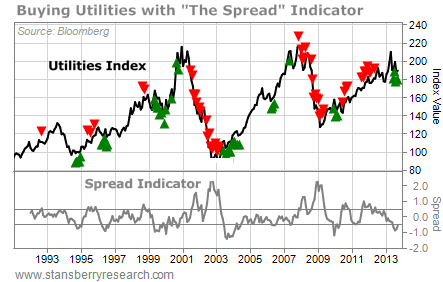 This is one of my top income ideas right now…
This is one of my top income ideas right now…
Over the past two days, I’ve showed you how to “time” your purchases on big blue-chip stocks and MLPs.
Today, I’m going to show you how to do the same thing for another classic income-investor favorite: utility stocks.
Utility companies – which provide power, water, and natural gas – enjoy guaranteed profits.
[ad#Google Adsense 336×280-IA]If you want indoor plumbing or a refrigerator, you have to do business with the municipal utility company.
In exchange for their monopoly position, utilities accept regulations that limit their ability to raise prices…
Essentially, municipalities assure reliable power for themselves in exchange for guaranteeing the companies’ profits.
The government-guaranteed profit turns these companies into income-producing machines.
Utilities don’t have the same kind of growth opportunities as traditional companies. So that cash turns into dividend payments.
That’s why these stocks have been a good friend to retirees and other income investors for generations.
But as I’ve been showing you this week, the better you can time your purchases with income-paying assets, the better you’ll do over the long term.
Again, when I’m looking for a good buy point, I start with the yield…
Right now, utilities (as measured by the S&P 500 Utilities Index) pay about 4%. To judge if 4% is a high or low yield, I compare it to the yield on 10-year corporate bonds. The difference between the two yields is the “spread.”
Then I compare the size of the spread right now to the average of the spread over the last year. That helps me pinpoint short-term selloffs, which can be good times to buy.
This measure makes a powerful indicator. As you can see, by buying when the indicator is low (below -0.5) and selling when it is high (above 0.5), you can catch most of the big bull markets… and sidestep the big selloffs.
 In the three months after a buy signal, utilities return an average of 1.7%… compared to the typical three-month return of 1%. It sounds like a small improvement. But if you followed this strategy from 1995 to today on the S&P 500 Utilities Index, you would have made 208%, versus just 56% from a buy-and-hold strategy.
In the three months after a buy signal, utilities return an average of 1.7%… compared to the typical three-month return of 1%. It sounds like a small improvement. But if you followed this strategy from 1995 to today on the S&P 500 Utilities Index, you would have made 208%, versus just 56% from a buy-and-hold strategy.
Like I said, right now, the average utility pays about 4%. That’s a little below the sector’s 20-year average. But it’s actually a high payment considering the low yields on other investments with the Federal Reserve keeping rates so low.
In other words, my indicator says utilities are a buy. That means quality utilities – like CMS Energy (CMS) at 3.7%, Dominion Resources (D) at 3.5%, and Duke Energy (DUK) at 4.3% – offer good investment opportunities.
If you’re looking for safe income, start here.
Here’s to our health, wealth, and a great retirement,
Dr. David Eifrig
[ad#stansberry-ps]
Source: The Growth Stock Wire
